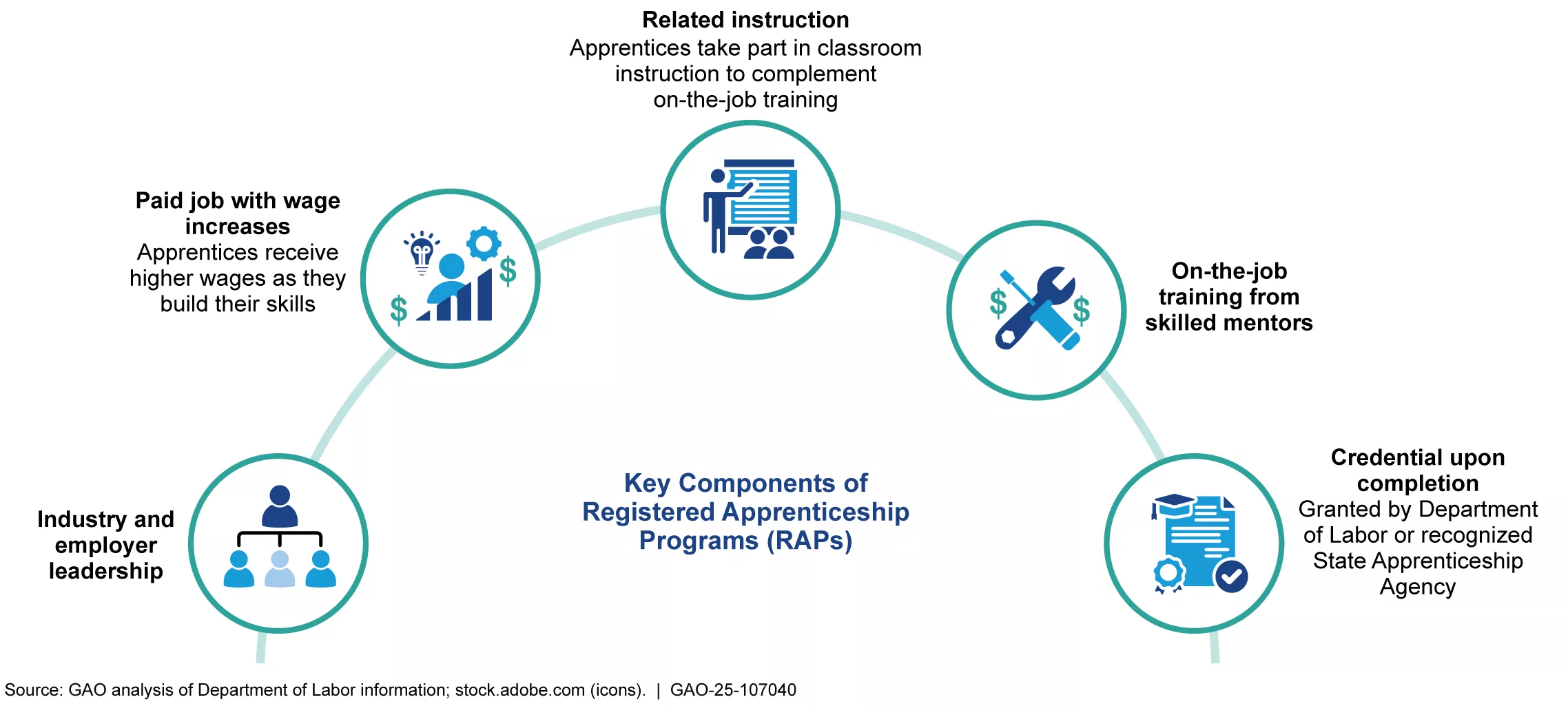How Apprenticeship Programs Could Help Fill In-Demand Jobs
For workers and jobseekers, apprenticeships can offer opportunities to gain practical work experience and instruction while earning a paycheck.
Some of the more common apprenticeships are in career fields with a high demand for workers. Employers in fields like health care, financial services, hospitality, construction, and more use apprenticeships as a pipeline to fill positions with skilled workers.
Today’s WatchBlog post looks at our new report on federal efforts to provide “earn-and-learn” opportunities through Registered Apprenticeship Programs.
Image

Apprenticeship programs offer benefits for both workers and employers
Earn and learn opportunities vary widely, including a range of apprenticeships and other employer-involved initiatives—such as internships, co-ops, or work-study.
Among these options, Registered Apprenticeship Programs provide structured earn-and-learn opportunities that combine on-the-job training and mentorship, classroom instruction, progressive wage increases, and recognized credentials. The Department of Labor (Labor) partners with state apprenticeship agencies to oversee and certify that registered apprenticeship programs include these components, such as classroom-based instruction to complement on-the-job training and guidance from mentors.
Key Components of Registered Apprenticeship Programs
Image

Registered Apprenticeship Programs enrolled about 940,000 people in fiscal year 2024 across a variety of industries, including some mentioned above, but also in cybersecurity and shipbuilding, among others. About half of all program participants are in the construction industry. In April, the administration announced plans to expand the programs. Our work was completed before this announcement.
Participants saw benefits beyond being paid while gaining on-the-job training. This included access to education without taking on student loan debt, industry-recognized credentials and connections, and increased wages over time.
Labor reported that people who completed a registered apprenticeship program earned an average annual salary of about $80,000 in fiscal year 2023. That average salary was higher than the average for associate’s degree holders.
Image

Employers saw benefits too by developing and preparing their future workforce—especially in rapidly growing occupations needing skilled workers. Employers said apprenticeships lead to positive return on investment through higher employee retention and the ability to fill critical workforce gaps. For example, two health care organizations said that they had implemented nursing apprenticeship programs partly because it cost less to develop hospital staff via apprenticeships than to hire traveling nurses.
We found at least 26 federal programs across the Departments of Commerce, Defense, Education, Labor, and Veterans Affairs that can support such earn-and-learn opportunities. Some of these programs targeted specific populations or industry sectors. For example, 20 programs targeted populations like veterans, youth, military service members, or disabled workers. The most popular occupations among fiscal year 2024 registered apprentices were concentrated in the construction trades—electricians, plumbers, and carpenters—but also included computer and health care occupations.
While successful, some challenges may slow expansion of these programs
There are some challenges that could affect the expansion of federal earn-and-learn opportunities, including:
Awareness. Over the past few years, federal agencies have implemented several initiatives to publicize Registered Apprenticeship Programs. For example, Labor’s Apprentice Trailblazer Initiative used a national network of program graduates to share their experiences with job seekers and tout the benefits of participating in them.
Low starting wages. Even with the long-term rewards, some program participants may drop out when pay is at its lowest—particularly during the first 6 months of an apprenticeship. To help, some agencies have funds that can be used to help workers facing economic hardship. For example, Commerce and Labor administer programs that can provide funding for supportive services—such as childcare and transportation—for earn-and-learn participants.
Administrative burden and costs. Some employers expressed concerns about costs related to start-up, instruction and training materials, mentors’ time, and overhead to cover earn-and-learn opportunities. To help, some funds were available to offset employer costs for apprenticeships. For instance, Labor grants helped employers cover costs for about 3% of registered apprentices during fiscal year 2024. Many states also offered tax credits to businesses hiring apprentices and tuition support for apprentices participating in these programs. In Chicago, a consortium of companies, unions, and education partners built a network to support apprenticeships—creating about 2,000 apprenticeship positions.
For more information on Registered Apprenticeship Programs, be sure to read our new report.
- GAO’s fact-based, nonpartisan information helps Congress and federal agencies improve government. The WatchBlog lets us contextualize GAO’s work a little more for the public. Check out more of our posts at GAO.gov/blog.
- Got a comment, question? Email us at blog@gao.gov.
GAO Contacts
Related Products

GAO's mission is to provide Congress with fact-based, nonpartisan information that can help improve federal government performance and ensure accountability for the benefit of the American people. GAO launched its WatchBlog in January, 2014, as part of its continuing effort to reach its audiences—Congress and the American people—where they are currently looking for information.
The blog format allows GAO to provide a little more context about its work than it can offer on its other social media platforms. Posts will tie GAO work to current events and the news; show how GAO’s work is affecting agencies or legislation; highlight reports, testimonies, and issue areas where GAO does work; and provide information about GAO itself, among other things.
Please send any feedback on GAO's WatchBlog to blog@gao.gov.




